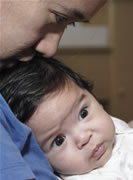
In This Issue
Latina Baby Care Traditions
For a Latina, becoming a mother can be a moment of great pride and joy; yet, becoming a mother in a country other than her own can be scary and confusing. Many new Latina mothers can feel insecure about how to care for their newborns properly. This insecurity is often the result of hearing contradictory advice.
Long before the baby arrives, Latinas begin to receive informal advice about pregnancy and baby care from their mothers, grandmothers, aunts and other experienced mothers in their community. At the same time, Latinas receive advice from their healthcare providers. Formal medical advice may be taken with suspicion or not be heard at all, if it contradicts long-standing tradition.
Latino culture is full of traditions about baby care and what to do when the baby is sick. Many of these traditions have been practiced for generations. Such traditions may be instilled strongly in Latina immigrants from small Latin American rural towns or indigenous communities. However, even well-educated Latinas observe some traditions too. Awareness of these traditions is important, as it can help increase cultural competence and better server Latina clients and their  families. Here are five common traditions:
families. Here are five common traditions:
- Evil eye (mal de ojo)
Mal de Ojo is a supposed power bestowed on a person whereby his/her glance brings sickness, bad luck, calamity or death. A baby's vomiting, fever , nonstop crying or restlessness are brought on by an admiring or covetous look from a person with an evil eye (especially green or blue). Parents may tie a red or pink string or bracelet loosely around a newborn's wrist or use a necklace with ojo de venado (deer's eye charm) or azabache (a black stone) to protect the baby. (The word ojo is pronounced o-ho).
Healthcare providers and others who come in contact with the family should be sure to touch the baby when paying complements. At the same time, providers should explain to the family that the amulet around the baby's neck or wrist can be a choking hazard and suggest putting the amulet on the stroller or car seat, but away from the baby's reach.
- The umbilical cord
It is believed that a newborn could take in air through its belly buttons, so the belly button should be covered with an ombliguera ( a kind of gauze or fabric made for wrapping snugly around the baby's tummy). Often a small cotton ball covered by a coin or a button and held together by the ombliguera is used. This band is thought to prevent a hernia or keep the belly button from becoming an "outie".
While covering the belly button is not necessarily harmful, it is important to emphasize to new mothers that the stump is an opening in the skin that has to heal, and the best way to care for it is to keep it dry, clean and exposed as much as possible. Covering it with something while the stump has not fallen off can cause an infection.
- Sunken fontanel (caída de la mollera)
According to tradition, the fontanel (soft spot of the skull) becomes sunken when a baby is withdrawn from the nipple too suddenly. It is also said that this can happen if someone puts a newborn in a sitting-down position or frightens the infant. Popular remedies for a sunken fontanel are to hold the baby upside-down and strike the soles of the baby's feet or press a thumb against the roof of the baby's mouth or place a raw egg yolk in the depressed area and allow it to dry. These maneuvers could be dangerous for a baby.
Giving information to parents prior to delivery about normal newborn appearance, as well as in the first pediatric visit after delivery, is an important step in providing information to new parents who will be worried about the fontanel. Even more important, mothers need to know that a sunken fontanel is a sign of dehydration and they should seek immediate medical assistance for the baby if it happens.
- Overdressing and bundling the baby
Traditional Latino beliefs rely heavily on theories related to cold and heat. Something cold can cause an illness by chilling the body - "te dio un aire." Common colds, fevers or flu are caused by the cold wind or an abrupt change of temperature. It is believed that babies feel the cold more than adults do, and therefore need to be bundled up more and overdressed, even in warm temperatures.
Bundling babies excessively can make them uncomfortable and cause other problems such as heat rash. Overdressing a sleeping baby also has been related to a higher risk of sudden infant death syndrome (SIDS).
Take this as an opportunity to inform the new parents about SIDS and to give tips to protect baby, such as keeping a room temperature between 68° F and 72° F. Also indicate to the mother that if her baby is cold, he/she will alert her by crying so she should err on the side of less layers and blankets.
- Colicky babies
To treat this condition, Latinas use chamomile or star anise to ease colic in newborns. Some doctors advise not to give a young baby herbal teas or home remedies. Before age 4 to 6 months, a child's digestive system isn't ready for anything other than breast milk or formula, and herbal remedies might cause diarrhea or other health problems.
Emphasize that breast milk is the best food for the baby. Suggest changes in the diet for the mother to rule out any foods that might be upsetting the baby's stomach.
 Like any other mothers, Latino parents are only concerned with doing the best for their babies. Home remedies and support from lay healers (curanderas/os) are important parts of Latino culture. Some traditions can be harmless while others can pose a health risk to the baby. As health professionals, we need to be aware of Latino folk medicine and practices and respectfully ask parents if previous treatments or remedies were given at home. Be sure to build trust with Latino parents by asking questions without judgment. Watch body language and tone of voice. Involve parents in decision-making and be open to the idea that they might still consult a lay healer for asecond opinion or treatment.
Like any other mothers, Latino parents are only concerned with doing the best for their babies. Home remedies and support from lay healers (curanderas/os) are important parts of Latino culture. Some traditions can be harmless while others can pose a health risk to the baby. As health professionals, we need to be aware of Latino folk medicine and practices and respectfully ask parents if previous treatments or remedies were given at home. Be sure to build trust with Latino parents by asking questions without judgment. Watch body language and tone of voice. Involve parents in decision-making and be open to the idea that they might still consult a lay healer for asecond opinion or treatment.
A Note About Breastfeeding
Breastfeeding can be particularly difficult for Latinas without family support in the area, more so for first-time mothers. Common myths and traditional beliefs add an extra layer of barriers to breastfeeding. Consider the following and provide supportive advice to your clients:
- Myth: Women with small breasts do not produce enough milk to nurse a baby.
Fact: Breast size is not important. A healthy diet and frequent breastfeeding to establish milk supply are important.
- Myth: I don't have enough milk. My baby does not get full breastfeeding and wants to nurse all the time.
Fact: It is normal for babies in the first few months to breastfeed frequently. Frequent breastfeeding will help establish milk production. If a mom is concerned that her baby is not getting enough milk, it is important to observer if the baby is latching properly and/or if baby is feeding effectively (i.e., baby is swallowing and awake for 10-15 minutes at a time). Encourage your clients to use these frequent feedings as an opportunity to rest and bond with their babies. Also, provide them with support throughout this difficult time.
- Myth: You cannot get pregnant while you are nursing.
Fact: Even though breastfeeding can delay ovulation and menstruation, it is impossible to predict when fertility will return. Women can still become pregnant while breastfeeding. Make sure to talk to your patients about safe contraceptives while nursing.
Latinas who experience susto (fright), a folk-illness caused by one frightful incident, will stop breastfeeding to prevent passing the condition to their babies through their breastmilk. Susto can be cured by undergoing a limpia (cleansing) or barrida (sweeping) in which herbs are swept over the sufferer's body. Be respectful and offer an alternative option to weaning the baby, such as teaching how to use a pump to express mile to maintain milk supply and to resume breastfeeding once the susto has been cured.
- Hispanic women are younger, on average, than other women in the United States. The median age of Hispanic women is 41, compared with 47 for non-Hispanics women
- Among Hispanic women, immigrants are more likely to give birth than their U.S.-born counterparts. Immigrant Hispanic women had 96 births per 1,000 women while U.S.-born Hispanic women had 73 births per 1,000 women.
- Hispanic women, especially immigrant Hispanic women, are much less likely to have health insurance than non-Hispanic women.
- In North Carolina, more than 60% of Hispanic had no health coverage, compared to 11% of white, non-Hispanic women
Sources:
Hispanic Women in the United States 2007, Pew Hispanic Center
2007 North Carolina Women's Health Report Card, Center for Women's Health Research
 Guide for First-Time Parents (Nemours Foundation). Also available in
Guide for First-Time Parents (Nemours Foundation). Also available in  Spanish
Spanish  What is the Best Treatment for Infants with Colic? (Family Physicians Inquiries Network)
What is the Best Treatment for Infants with Colic? (Family Physicians Inquiries Network)
 Finding a Doctor for Your Child (Nemours Foundation). Also available in
Finding a Doctor for Your Child (Nemours Foundation). Also available in  Spanish
Spanish
 Hispanic Folk Illnesses (Creighton University Medical Center)
Hispanic Folk Illnesses (Creighton University Medical Center)  Traditional Medicine Curanderismo within the Hispanic/Latino Population in NC, presentation by Steve Davis at 2008 Minority Health Conference
Traditional Medicine Curanderismo within the Hispanic/Latino Population in NC, presentation by Steve Davis at 2008 Minority Health Conference
-
What remedies have you given to your baby?
¿Qué remedios le ha dado a su bebé?
-
Your baby is dehydrated.
Su bebé está deshidratado (de-SEE-drah-ta-dough).
-
Don't cover the baby too much.
No tape mucho a su bebé. - Keep the baby’s belly button clean and dry.
Mantenga el ombligo del bebé limpio y seco.
- It’s normal for your baby to eat every two hours.
Es normal que su bebé coma cada dos horas.